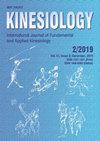The effect of isolated or combined small-sided games and speed endurance training on physical performance parameters in young soccer players
IF 0.9
4区 医学
Q4 REHABILITATION
引用次数: 5
Abstract
The purpose of this study was to investigate the effects of six weeks of small-sided games (SSG), speed endurance (SER) and combined SSG and SER (CT) training programs on sprint, repeated sprint, Yo-Yo intermittent recovery test level 1 (Yo-Yo IR1) and level 2 (Yo-Yo IR2) performance in young soccer players. Forty-one elite young soccer players (body height: 174.0 ± 7.5 cm, body weight: 59.7 ± 9.5 kg, age: 14.6 ± 0.5 years, training age: 7.4 ± 0.6 years) underwent anthropometric measurements before performing 10m and 30m sprint tests, repeated sprint tests, and Yo-Yo IR1 and Yo-Yo IR2. The players were then divided into four groups: the SSG group (SSG; n=11), the SER group (SER; n=10), the CT group (CT; n=11), and the control group (CG; n=9). All groups performed training for six weeks on two days out of the five training days the participants were undertaking. There was a statistically significant increase in the Yo-Yo IR1 and Yo-Yo IR2 test performances of players in SSG, SER and CT groups (p<.05). In addition, players in these groups showed significantly higher percentage increases in Yo-Yo IR2 test performance compared to the CG. The CT group also had a statistically significant increase in Yo-Yo IR1 test performance compared to the CG (p<.05). In conclusion, while this study shows that SSG and SER training can be used for physical performance development in isolation or in combination, coaches and sports scientists are advised to choose combined training to use training time more efficiently.小场地比赛和速度耐力训练对青少年足球运动员身体机能参数的影响
摘要本研究旨在探讨为期六周的小边比赛(SSG)、速度耐力(SER)以及SSG和SER (CT)联合训练方案对青少年足球运动员短跑、重复短跑、溜溜球间歇恢复测试一级(溜溜球IR1)和二级(溜溜球IR2)成绩的影响。41名优秀青少年足球运动员(身高174.0±7.5 cm,体重59.7±9.5 kg,年龄14.6±0.5岁,训练年龄7.4±0.6岁)在进行10米和30米短跑测试、重复短跑测试和溜溜球IR1和溜溜球IR2之前进行了人体测量。然后将参与者分为四组:SSG组(SSG;n=11), SER组(SER;n=10), CT组(CT;n=11),对照组(CG;n = 9)。所有小组都进行了为期六周的培训,参与者在五天的培训中有两天进行了培训。SSG组、SER组和CT组运动员悠悠球IR1和悠悠球IR2测试成绩有统计学意义(p< 0.05)。此外,与CG组相比,这些组的玩家在溜溜球IR2测试中的表现显著提高。与CG组相比,CT组在溜溜球IR1测试中的表现也有统计学意义的提高(p< 0.05)。综上所述,虽然本研究表明SSG和SER训练可以单独或联合用于体能发展,但建议教练员和运动科学家选择联合训练,以更有效地利用训练时间。
本文章由计算机程序翻译,如有差异,请以英文原文为准。
求助全文
约1分钟内获得全文
求助全文
来源期刊

Kinesiology
REHABILITATION-SPORT SCIENCES
CiteScore
1.90
自引率
8.30%
发文量
16
审稿时长
>12 weeks
期刊介绍:
Kinesiology – International Journal of Fundamental and Applied Kinesiology (print ISSN 1331- 1441, online ISSN 1848-638X) publishes twice a year scientific papers and other written material from kinesiology (a scientific discipline which investigates art and science of human movement; in the meaning and scope close to the idiom “sport sciences”) and other adjacent human sciences focused on sport and exercise, primarily from anthropology (biological and cultural alike), medicine, sociology, psychology, natural sciences and mathematics applied to sport in its broadest sense, history, and others. Contributions of high scientific interest, including also results of theoretical analyses and their practical application in physical education, sport, physical recreation and kinesitherapy, are accepted for publication. The following sections define the scope of the journal: Sport and sports activities, Physical education, Recreation/leisure, Kinesiological anthropology, Training methods, Biology of sport and exercise, Sports medicine and physiology of sport, Biomechanics, History of sport and Book reviews with news.
 求助内容:
求助内容: 应助结果提醒方式:
应助结果提醒方式:


